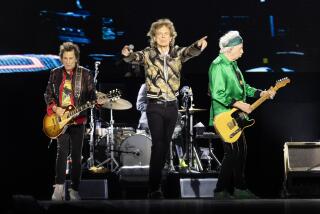A Knock on Rock Movies : How ‘Great Balls of Fire,’ the latest failed rock bio, reduces Jerry Lee Lewis to Roger Rabbit
After 30 years of rock ‘n’ roll movies, is it too much to ask Hollywood to make a biography that reaches for insight rather than nostalgia; a film with enough imagination and heart to add to a performer’s artistic legacy rather than belittle it?
The current “Great Balls of Fire,” ironically, ends just where the real drama in Jerry Lee Leiws’ life began: the time in 1959 when the proud hellcat--accustomed to being paid thousands of dollars a night in the nation’s top ballrooms and theaters--was forced to settle for $100 a show in backwoods Southern honky-tonks.
Lewis, a man of relentless determination and ego, eventually returned to bigger paydays, scoring hits in the country field in the late ‘60s and then benefiting from the ‘50s rock revival in the ‘70s and ‘80s. He remains an arresting live performer who, far more than Chuck Berry or Fats Domino, represents the purest active taste of the original rock ‘n’ roll spontaneity and independence.
But you’d never know that from the movie.
“Great Balls of Fire” could have been the classic film biography.
Dennis Quaid was an inspired choice to play Jerry Lee, the piano-pumping Louisiana wild man who was so notorious during rock’s early days that he made anxious parents think Elvis Presley wasn’t so bad after all. Elvis may have shaken his hips when he sang, but he had manners when he was around adults and he knew the importance of discretion.
Jerry Lee bowed to no man and he didn’t see anything wrong in telling the world about his marriage to his 13-year-old cousin, Myra Gale Brown.
In Winona Ryder (she’s 17), director Jim McBride also had an actress who reflects marvelously the conflicting emotions that must have been going through 13-year-old Myra Gale when Jerry Lee suddenly reached out to her: the urges that accompany sexual awakening, the intoxication of being close to somebody so famous, and the underlying fear that Jerry Lee could someday go over the edge. And the singer does turn suddenly violent in a scene after his downfall.
With all these elements in place, however, McBride fails badly. Rather than explore Lewis’ character, McBride, who co-wrote the script with Jack Baran, ends up simply satirizing the argyle innocence and daffy exuberance of the ‘50s.
By concentrating on the nostalgia of the ‘50s rather than the complexities of Lewis, McBride leaves us with a film as colorful, slick and soulless as the new breed of neighborhood ‘50s diners. There are hints of Lewis’ dark, self-destructive streak and his dirt-poor origins in “Great Balls of Fire,” but it is all kept far in the shadows.
With no depth of story or character to support him, Quaid--sadly--ends up appearing hammy and even goofy, whether assaulting the piano, strutting around the house or driving through town in his shiny new convertible.
“Great Balls of Fire” is the toon of rock movies, with Jerry Lee Lewis reduced on screen to Roger Rabbit.
Jerry Lee Lewis may be a lot of things, but he’s not a simple cartoon.
No one in rock--even youngsters half his age--has had a bigger reputation for hard living and hard drinking. Lewis was on the road as much as 250 nights a year for two decades--and it almost killed him. It was touch and go in 1981, doctors said, as they worked to repair a tear in Lewis’ stomach lining.
Tragedy, meanwhile, seemed to stalk Lewis at every turn. One of his sons died in a swimming pool, another died in a jeep accident. His fifth wife, Shawn, died of a drug overdose in 1983 under suspicious circumstances. “20/20” and Rolling Stone magazine both raised questions about Lewis’ possible implication in the death.
In an interview just weeks after the delicate stomach operation in 1981, Lewis sat backstage at a Longview, Tex. ballroom and said, “I’ll tell
you what it was--all those years of going, going, going. I think my stomach just finally wore out. I’ve got to start taking better care of myself.”
With a showman’s timing, Lewis flashed a wide grin and added, “Now where’s that whiskey?”
Rock ‘n’ roll movies in the ‘50s at least had the rock stars themselves in front of the camera. They were mostly quick exploitation films, offering fans--in the days when rock concerts were still rarities--a chance to see a parade of their favorites do their hits. The plots were no more imaginative than the titles of the film: “Don’t Knock the Rock,” “Rock, Rock, Rock” and “Go, Johnny, Go.”
In “Don’t Knock the Rock,” a riot breaks out at a rock dance and city fathers blame the music, but disc jockey Alan Freed finally convinces everyone that rock is really a healthy outlet. All this goes on between the real action and lure of the film: numbers by rock stars Bill Haley and Little Richard.
In “Shake, Rattle and Rock,” a citizens’ group again wants the ban rock, but another disc jockey (this time played by Touch Connors) again saves the day. The real lure: the songs by Fats Domino and Joe Turner.
Even the plots of Elvis Presley’s early movies were simply stock “pop star” vehicles, but Elvis’ presence alone in “Jailhouse Rock,” “Loving You” and “King Creole,” conveyed far more of the rock experience than the toothless nostalgia of “The Buddy Holly Story” and “Great Balls of Fire.”
Two new forms of rock movies eventually took their place alongside the the early star vehicles: documentaries and the biographies. The documentaries--from the pure musical celebration of “Monterey Pop” in 1968 and “The Last Waltz” in 1978 to the violence and chaos of “Gimme Shelter” in 1971--have been the far more valuable.
The best was D. A. Pennebaker’s “Don’t Look Back,” a chronicle of Bob Dylan’s 1965 solo tour of England. It was an unforgettable glimpse of what’s it’s like to be a creative artist virtually under siege by both the press and fans. It shows Dylan, only a couple of years older than the Lewis as shown in “Great Balls of Fire,” being alternately intrigued by the fan worship and repelled by it. “Don’t Look Back” might not unravel the mystery of Dylan, but it gives us a memorable look inside his world.
Another classic rock film of the ‘60s, Richard Lester’s “A Hard Day’s Night” in 1964, was a bridge between the old exploitation rock vehicles of the ‘50s and the emerging documentary style as --partly scripted and partly improvised--it celebrated the Beatles’ vitality and charm.
For all its ambition, Prince’s “Purple Rain” in 1984 was a throwback to the ‘50s exploitation films--showcasing Prince the same way that, say, “Jailhouse Rock” showcased Elvis. The story was corny and confusing, but Prince’s electrifying performance gave the film a wallop that far outclassed the biographies.
Few stars can carry a film the way Presley and Prince have (and Prince’s follow-up, “Under the Cherry Moon,” showed just how much trouble he had on the screen when stepping outside of his musical persona), so the best chance at quality in a rock movie remains the documentaries.
Yet the biographies--however shallow and contrived--seem to represent the best chance at a solid box-office return, so Hollywood will be forever tempted by them. The music and continuing affection for early rock heroes gives the film makers a head-start on connecting with a wide audience.
There are plenty of ‘50s performers to choose from: Rick Nelson, Little Richard, Sam Cooke, Fats Domino. And, then there are the ‘60s stars. Films are already under way or under discussion about Jim Morrison, Otis Redding and Jimi Hendrix. Ultimately, someone will attempt a Dylan biography.
The latter is enough to make you shudder.
More to Read
Only good movies
Get the Indie Focus newsletter, Mark Olsen's weekly guide to the world of cinema.
You may occasionally receive promotional content from the Los Angeles Times.










